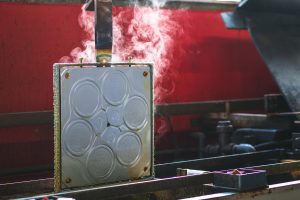A good maintenance schedule for moulds for rubber technical articles is fundamental to limit the economic investment. In fact, a moulder working with unmaintained moulds risks producing defective and therefore unusable articles. Consequently, production is blocked, causing a loss in time and money. For this reason, the maintainer’s job is fundamental in the moulding field.
To organise the best mould maintenance system, it is necessary to own a database for each mould. Only by updating it, will it be possible to define the mould’s production limit. Once this limit has been reached, it is necessary dechrome and then rechrome the mould in order to reuse it. If you don’t pay attention to this guaranteed limit, the mould may keep moulding even though it has small imperfections. This will result in non-conforming moulded parts that will have to be discarded, entailing higher costs and increased production time. Moreover, the continued use of an imperfect mould would lead to such a state of wear of the steel that it would need to be reworked at a higher cost.

Risks of extraordinary maintenance
If the company does not have a mould usage record, maintenance becomes unpredictable. In fact, it often happens that the operator suddenly (before starting the moulding cycle) realises that the mould is no longer in the best condition and cannot be used because the surface is damaged, and it would cause imperfections on rubber technical articles. This kind of behaviour can hinder production and cause dissatisfaction among the operators. Our advice to avoid any production slowdown is to implement a preventive maintenance plan.
Advantages of preventive maintenance
In this case, the operator, at the end of the cycle, has the task of checking the conditions of the mould, the centring, and the chrome plating layer. Our advice is to program each preventive maintenance operation so as to extend the lifetime of the mould and to track the steps made. This maintenance system is best, as it allows one to have a stock of moulds ready for use, avoiding extraordinary and emergency maintenance.
The mould database enables the implementation of a preventive plan and the best management of moulding cycles, improving productivity and sustainability of the operators’ work.
At O.C.S. we believe that maintenance is a key factor to determine the lifetime of a mould.
For this reason, we work side by side with our customers, ready to answer all their questions or needs. Click here and read our answers to the 5 frequently asked questions about the maintenance of moulds



